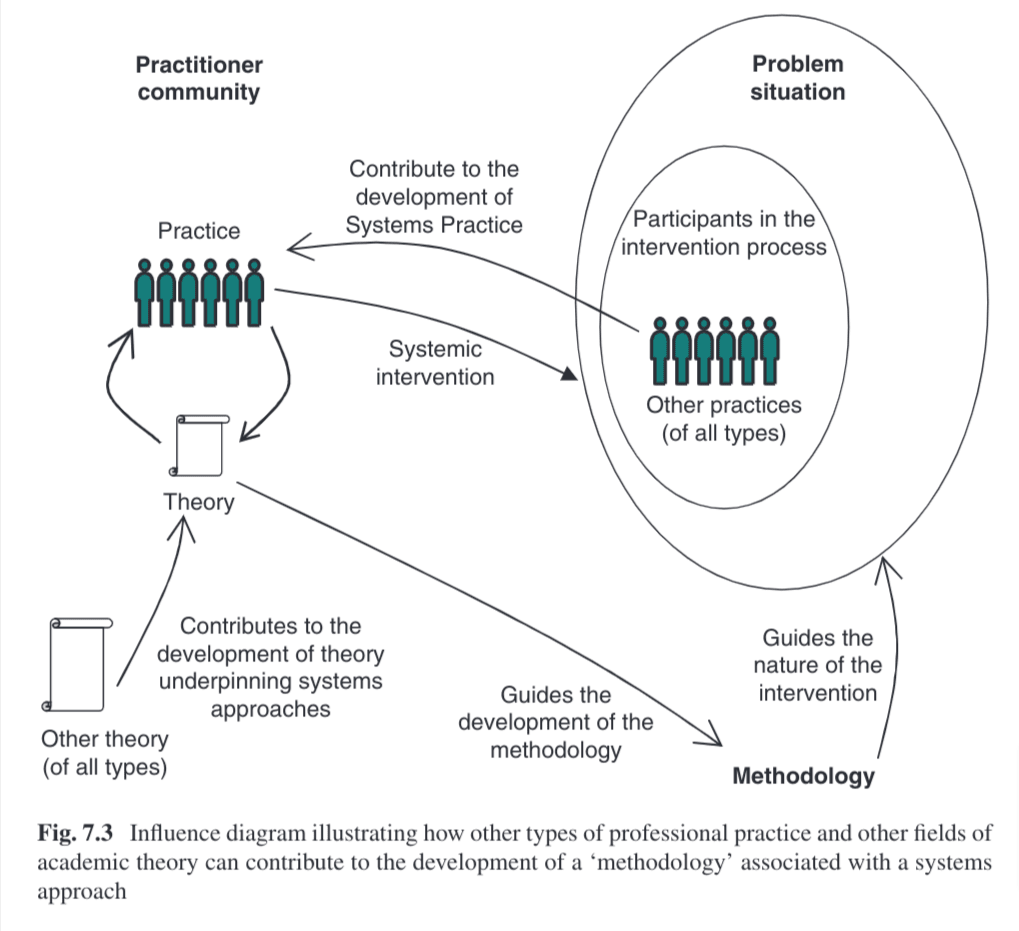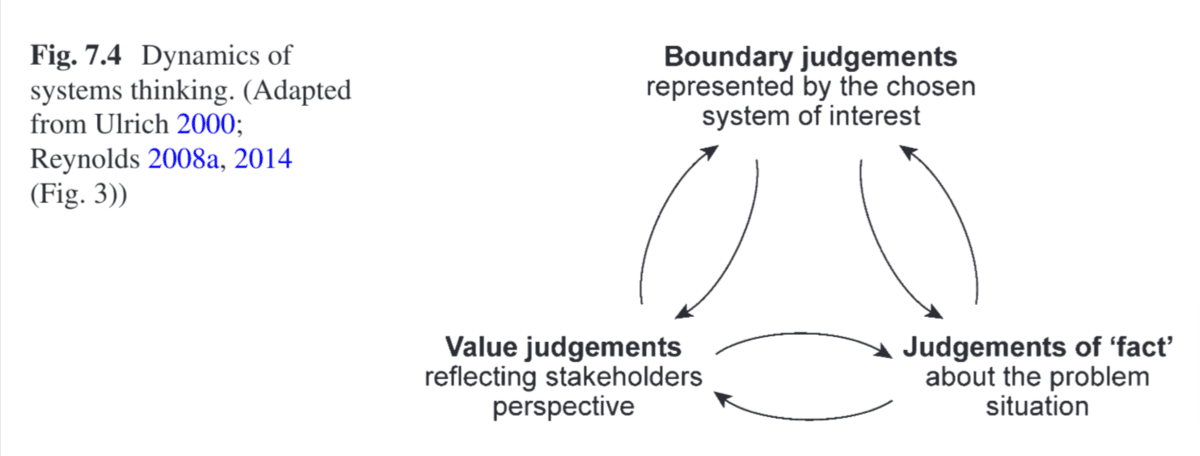TB871: Combining five systems approaches
Note: this is a post reflecting on one of the modules of my MSc in Systems Thinking in Practice. You can see all of the related posts in this category.
Update: It’s been almost three weeks since I last posted anything related to my studies. During that time I’ve been working on my third tutor-marked assessment and then taking a bit of a break. In fact, I’m probably going to be pausing my studies for six months for a more extended break; the Open University only gives students a week between modules, which didn’t make the Christmas holidays last year very relaxing!
I’ve published two of a three-part introduction to systems thinking on the WAO blog which you may be interested in if you’re new to this area.

I’m coming towards the end of module TB871 and therefore thinking about my End of Module Assessment (EMA) which pulls together everything I’ve learned over the past few months. This post will largely comprise of my notes on Chapter 7 of Systems Approaches (Reynolds & Holwell, 2020) in which the five systems approaches covered in the book are compared and contrasted.
Those five systems approaches are:
- System Dynamics (SD)
- Viable Systems Model (VSM)
- Strategic Options Development and Analysis (SODA)
- Soft Systems Methodology (SSM)
- Critical Systems Heuristics (CSH)
In terms of what these have in common, there are four main areas which Reynolds and Holwell mention (2020, pp.308-309):
- Dealing with complexity: All five approaches are designed to handle complex situations and issues, focusing on understanding and improving these situations rather than offering simple solutions.
- Systems concepts: They are grounded in core systems concepts such as:
- Emergence: Each approach considers the property of the whole that emerges from the interaction of its parts, where the whole is more than the sum of the parts.
- Hierarchy: They acknowledge the presence of different layers or levels in systems.
- Communication: These approaches stress the importance of communication within the system, including the development of shared understanding through listening and dialogue.
- Control: Each approach deals with the actions required to maintain system stability and ensure long-term survival.
- Inter-relationships, perspectives, and boundaries: All approaches give importance to inter-relationships, considering multiple perspectives and making boundary judgements (determining what is included or excluded) as a key aspect of systems practice.
- Application and community: Each approach has been shaped by the collective experience of a diverse group of practitioners from various professional backgrounds, contributing to its development in real-world practice.
In addition, they also share the following characteristics (Ibid., pp.310-311):
- Cyclic and iterative process: All five approaches involve a cyclic and iterative process for dealing with complex situations. Changes in perspective and hierarchy often lead to new insights, which then require revisiting earlier conclusions. This iterative nature ensures continual refinement and understanding.
- Focus on understanding the whole: Each approach emphasises the importance of gaining a comprehensive understanding of the situation. They prioritise achieving a rich understanding of the entire context rather than focusing on narrow or simplistic views of problems.
- Use of models and diagrams: All five approaches make extensive use of models and diagrams as conceptual tools to facilitate learning and understanding. These models are seen as constructs to aid thinking and reflection, rather than direct representations of reality.
- Conceptualisation of entities: While each approach models different entities (e.g., variables in SD, processes in VSM, options in SODA, activities in SSM, and sources of influence in CSH), they all use modelling to clarify connections and relationships within the system.
- Emphasis on improvement, not resolution: Rather than seeking definitive solutions or fixes, these approaches focus on making improvements to the situation. They regard situations as opportunities for continuous development and refinement rather than problems to be simply resolved.
Systems thinking isn’t a tick-box exercise but requires a systemic approach. Practitioners such as Donald Schön used metaphors such as jazz to explain this: “the process of improvisation in the moment based on a response to the situation (what other musicians are playing, the audience’s response etc), to the established rhythm and melody of the piece, and also on one’s own abilities and enthusiasms” (Ramage & Shipp, 2020, p.292, quoted in Reynolds & Holwell, 2020, p.311).
It was interesting to attend the Systems Innovation Network conference in London last week. There were some people there who were obviously deeply embedded in both theory and practice, but there were also plenty who were very much more on the practical side with a focus on a particular technique. Indeed, there was one session on Transition Design, which seems to be halfway between systems thinking and service design. Right now, I’m very much on the theoretical side, so it was fascinating to see how various people are putting theory into practice.

The above diagram shows the interaction between theories, methodologies, and communities (Reynolds & Holwell, 2020, p.315). What’s interesting to me is that this makes perfect sense in terms of my experience at the Systems Innovation Network conference. Practitioners of systems methods engage with other professional groups (e.g., teachers, managers, health workers) and non-professional participants during their practice. These interactions introduce new ways of thinking and contribute to the evolution of systems approaches by broadening perspectives.
This leads to a couple of routes of influence:
- External theories: Ideas from outside systems theory can shape the development of new theories within the systems community.
- External practices: Engaging with participants from different fields brings diverse practical insights that enhance systems practice.
As such, we should avoid ‘methodological purism’, instead adapting systems approaches based on context and incorporating insights from other domains. This flexibility supports the ongoing development of systems thinking and avoids the risks of group-think (Ibid., pp.314-316)
In my thesis, I used American Pragmatism as a methodology, leaning heavily on the ideas of Charles Sanders Peirce, William James, and Richard Rorty. All three rejected traditional ideas of ‘Truth’ with a capital ‘T’ but rather considered that truth would be what a community of inquirers agreed on at the end of inquiry (Peirce), good in the way of belief (James), or a socio-linguistic product (Rorty).
As such, I find Werner Ulrich’s notion of ‘boundary critique’ as part of CSH extremely useful. There is no objective reality to map, so we need to draw a boundary based on a particular view point. Doing so in a way that explicitly notes that this is one among many views is a powerful tool.

As shown in the diagram above, there is a ‘triadicity’ to this that links the work of Peirce, Habermas, and Checkland (Ibid., pp.316-317). When applying CSH and making boundary judgements, the systems practitioner also recognises that they are coming to the situation making certain other judgements about ‘value’ and ‘facts’. Given that systems are abstractions, or framing devices, when we notice changes in these judgements — either in ourselves or others — we need to understand that this changes the system (Ibid., p.317).
There is no ‘education system’, for example, but only ‘education systems’ as experienced by different individuals and groups (i.e. ‘stakeholders’). System thinking practitioners need to be wary that their favourite approach may not be particularly useful in a given situation. The idea is to have a range of approaches in a toolbox, and to perhaps combine them based on context.
For example, in this module I’m taking as my area of practice ‘community development and wellbeing’, my situation of interest ‘a system to support lifelong learning in the context of library services’, and
my system of interest ‘a system to support education and information’. Here’s how I could apply all five approaches:
- System Dynamics (SD): SD could model how different factors, such as library funding, community engagement, availability of digital resources, and staff training, interact over time to influence the success of lifelong learning initiatives. Feedback loops could help identify how increasing access to digital tools or creating more community programmes might impact learning outcomes, attendance at the library, and overall community wellbeing in the long run.
- Viable Systems Model (VSM): VSM could examine the organisational structure of the library service itself, ensuring that it can adapt to the changing needs of the community. It would explore how the library coordinates its services (e.g., learning programmes, digital literacy support, and access to information), while ensuring that all parts of the system (staff, management, technology providers) work in harmony to deliver these services effectively and sustainably.
- Strategic Options Development and Analysis (SODA): SODA could be used to map the different views of key stakeholders, such as library staff, lifelong learners, community members, local government, and educational institutions. This process could reveal differing perspectives on what lifelong learning in a library context should look like, generating strategies that balance resource allocation, the type of services offered, and the role of technology in supporting education and information access.
- Soft Systems Methodology (SSM): SSM could be employed to structure the issue by developing models that represent the system to support lifelong learning. Models could include a “system to improve digital literacy for older adults,” a “system to create a welcoming learning environment for all ages,” or a “system to integrate local educational content.” SSM would help clarify goals and develop practical interventions that align with the library’s role in the community.
- Critical Systems Heuristics (CSH): CSH could be applied to examine the power dynamics and ethical considerations within the system. It would ask critical questions about whose interests are being served by the library’s lifelong learning initiatives, whose voices are included or excluded in decision-making, and how the services could be more equitable. CSH would ensure that the system addresses not only educational needs but also inclusivity and fairness, particularly in terms of access to information for marginalised or underrepresented groups.
I’m not sure whether using all five in my EMA would be appropriate, but I’m currently thinking that SSM, CSH, and VSM would be useful. They would forma cycle of understanding, ethical reflection, and systemic viability which would ensure that the lifelong learning system would be not only effective but fair and sustainable.
I like how Reynolds and Holwell sign off the book with a quotation from Mary Catherine Bateson, which I’ll reproduce below. One of the things I’ve appreciated as I’ve continued my journey further into systems thinking is that it’s OK not to have the answers most of the time.
It’s confusing, but we have a right to be confused. Perhaps even a need. The trick is to enjoy it: to savor complexity and resist the easy answers; to let diversity flower into creativity. (Bateson, quoted in Reynolds & Holwell, 2020, p.320)
References
- Reynolds, M. and Holwell, S. (2020). Systems Approaches to Making Change: A Practical Guide, 2nd edn, London: Springer-Verlag.
Image: Nigel Tadyanehondo
